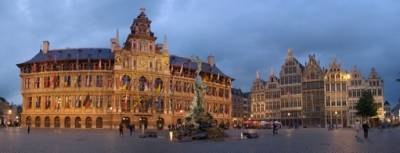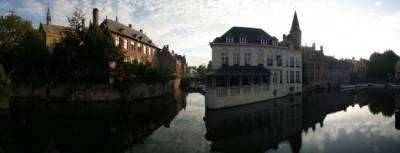Tourist Information
On this page you can find general tourist information about Belgium, Antwerp, and its major cities. Details about the conference center can be found in the Venue section. Information about how to reach Antwerp can be found in the Travel Info section.
About Belgium
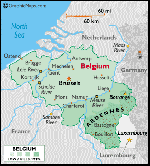 Belgium is situated in the west of Europe, bordered to the north by the Netherlands, to the east by Germany and the Grand Duchy of Luxembourg and to the south and the west by France. Although its surface area of only 32,545 square kilometers makes it a small country, its location has made it the economic and urban centre of Europe. Due to its central location, Belgium is a perfect hub to plan your tour of Europe (e.g., for city trips to Paris, Amsterdam, Berlin, Barcelona, …).
Belgium is situated in the west of Europe, bordered to the north by the Netherlands, to the east by Germany and the Grand Duchy of Luxembourg and to the south and the west by France. Although its surface area of only 32,545 square kilometers makes it a small country, its location has made it the economic and urban centre of Europe. Due to its central location, Belgium is a perfect hub to plan your tour of Europe (e.g., for city trips to Paris, Amsterdam, Berlin, Barcelona, …).
Since the time that Belgium was still called Belgica by the Romans, up until its independence in 1830, our country has successively been part of the Roman Empire, Spain, Austria, France and the Netherlands. We were visited by the Vikings and just about everyone else. Culturally we have been influenced by all of them. You can easily find these influences in our cities like Brussels, Bruges, Antwerp and many more.
Brussels, for instance, is not only Belgium's capital but also the one of Europe as it is the site of the headquarters of the European Commission, the Council of Ministers and the European Parliament. Other major international organizations, such as NATO, are also located in Brussels.
People
There are three communities living in Belgium. The Flemish, in the northern part of the country, speak Dutch. The Walloons, in the southern part of the country, speak French. Finally, in the far east of the country there is a German-speaking community. Brussels is a bilingual region (french and dutch, but english is also spoken by most citizens).
Although disparities exist between those living in different regions, Belgium is rated among the world's countries with the highest standard of living. Finally, crossed by language boundaries, socio-economic realities and different identity streams, Belgium has adopted an attitude of peaceful resolution of the conflicts that sometimes arise from this diversity. This is the famous “compromise Belgian style” which is said by some to be the source of the famous Belgian surrealist art.
Some famous Belgians you might have heard of are Adolphe Sax (musical instrument designer, inventor of the saxophone), Pieter Paul Rubens (17th century Baroque painter), René Magritte (surrealist artist), Panamarenko (assemblagist in sculpture), Andreas Vesalius (founder of modern human anatomy), Toots Thielemans (jazz musician well known for his guitar and harmonica playing) and Victor Horta (Art Nouveau architect).
What Belgium is most known for
 Belgium is famous for its beer, chocolate, waffles and its cuisine in general. Did you know that Flanders has more Michelin star restaurants per capita than France? Although every region has its special foods, the national dish of Belgium is considered to be mussels and fries.
Belgium is famous for its beer, chocolate, waffles and its cuisine in general. Did you know that Flanders has more Michelin star restaurants per capita than France? Although every region has its special foods, the national dish of Belgium is considered to be mussels and fries.
 Belgium produces more than 800 different kinds of beers, ranging from lagers and white beers to trappists (beer brewed at a monastery) and seasonal beers. A beer tasting is a mandatory activity for every visit to Belgium. There are plenty of pubs that offer a wide variety of brands, just make sure to try some of the (stronger) special beers (as opposed to the standard Pils or Pale Lager).
Belgium produces more than 800 different kinds of beers, ranging from lagers and white beers to trappists (beer brewed at a monastery) and seasonal beers. A beer tasting is a mandatory activity for every visit to Belgium. There are plenty of pubs that offer a wide variety of brands, just make sure to try some of the (stronger) special beers (as opposed to the standard Pils or Pale Lager).
Belgium is also well known for its comic books, which were highly influential in the development of the European comic book scene. Among the most famous are Tintin (Kuifje), The Smurfs (De Smurfen) and Willy and Wandy (Suske en Wiske).
Currency
 The currency used in Belgium is the European Union's Euro. As of June 2010, 1€ is worth about $1.23 (check current rate here). You can see what the Euro looks like at the site of the European Central Bank.
The currency used in Belgium is the European Union's Euro. As of June 2010, 1€ is worth about $1.23 (check current rate here). You can see what the Euro looks like at the site of the European Central Bank.
All major credit cards are accepted in most shops, hotels and restaurants. Banks are open on weekdays from 09:00 to 16:00. Automatic teller machines are widely available.
Electrical Outlets

 Belgium uses “Type C” and “Type E” electrical outlets operating at 230 Volts and 50 Hz. These outlets are commonly used in France, Italy and partly compatible with the Netherlands, Germany, …
Belgium uses “Type C” and “Type E” electrical outlets operating at 230 Volts and 50 Hz. These outlets are commonly used in France, Italy and partly compatible with the Netherlands, Germany, …
Weather
In February, the temperature varies between 1 and 8 degrees Celsius and we there is high probability of rain or snow. Even though rainy and snowy weather are common in February, it is not unusual to have a number of very sunny days as well. You can always consult the local weather forecasts of the local weather forecasts.
Smoking
According to Belgian law, it is forbidden to smoke in public places. Hence ALL congress facilities are non smoking areas. Also, smoking is forbidden in restaurants and restricted in pubs.
More Information
More information can be found on the following websites:
About Antwerp
 Antwerp lies on the banks of the River Scheldt and is with 500.000 inhabitants Belgium's second largest city. It is the second largest harbor of Europe (after Rotterdam). Moreover, Antwerp is a splendid city with numerous architectural highlights, most of which date from the 16th (the golden era of Antwerp) and the 17th century. The past is also represented by the numerous paintings of Peter Paul Rubens who lived in the Antwerp of the early 17th century.
Antwerp lies on the banks of the River Scheldt and is with 500.000 inhabitants Belgium's second largest city. It is the second largest harbor of Europe (after Rotterdam). Moreover, Antwerp is a splendid city with numerous architectural highlights, most of which date from the 16th (the golden era of Antwerp) and the 17th century. The past is also represented by the numerous paintings of Peter Paul Rubens who lived in the Antwerp of the early 17th century.
If diamonds really are a girl's best friend, than a lot of ladies will not leave out a visit to the diamond district around the Railway Station as Antwerp is the diamond center of the World.  Antwerp (Antwerpen in Dutch, Anvers in French) is the 2nd largest city of Belgium and the largest city of Flanders, the Dutch-speaking part of Belgium. Located on the banks of the river Scheldt, Antwerp has one the biggest seaports in the world. Antwerp is known for its culture, art, Rubens, fashion, beer, chocolates and lets not forget… diamonds!
Antwerp (Antwerpen in Dutch, Anvers in French) is the 2nd largest city of Belgium and the largest city of Flanders, the Dutch-speaking part of Belgium. Located on the banks of the river Scheldt, Antwerp has one the biggest seaports in the world. Antwerp is known for its culture, art, Rubens, fashion, beer, chocolates and lets not forget… diamonds!
Culinary delights
Antwerp has an impressive offer of enticing restaurants, fresh bakeries, coffee houses, chocolate stores, and pubs. In the cobbled lanes and back streets of its historic center, Antwerp hides some very fine restaurants offering you a typical Belgian cuisine. Fans of a more international cuisine will most certainly find their way to one of the many Italian restaurants or to Antwerp's Chinese street. Most pubs have an ample selection of beers, coming from a number of famous Belgian breweries – some of which are located in the city center of Antwerp. For example the De Koninck Brewery known for its “Bolleke Koninck” (5%), and Duvel Moortgat brewery known for the “Duvel” beer (8,5%).
Sightseeing & shopping
As you soak up Antwerp's unique atmosphere, be sure to pay attention to some architectural masterpieces during your walks through the city. 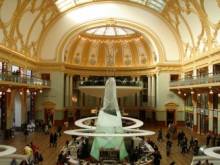 Be warned however, that you will most likely be distracted by glittering jewellery shops, trendy boutiques and the smell of warm waffles. Shopping in Antwerp is at its best, from the world's largest diamond center (it covers one square kilometer), to the lively shopping street, the Meir (one of the biggest shopping streets in Belgium), to designer boutiques and antique shops. Also make sure to visit the Stadsfeestzaal, the recently renovated city “ballroom” hall which was converted into a shopping mall (located on the Meir street).
Be warned however, that you will most likely be distracted by glittering jewellery shops, trendy boutiques and the smell of warm waffles. Shopping in Antwerp is at its best, from the world's largest diamond center (it covers one square kilometer), to the lively shopping street, the Meir (one of the biggest shopping streets in Belgium), to designer boutiques and antique shops. Also make sure to visit the Stadsfeestzaal, the recently renovated city “ballroom” hall which was converted into a shopping mall (located on the Meir street).  Over the years Antwerp has become one of the fashion cities of the world, with numerous young Flemish fashion designers (e.g., Dries Van Noten, Walter Van Beirendonck, Ann De Meulemeester, Dirk Bikkembergs) coming on the scene.
Over the years Antwerp has become one of the fashion cities of the world, with numerous young Flemish fashion designers (e.g., Dries Van Noten, Walter Van Beirendonck, Ann De Meulemeester, Dirk Bikkembergs) coming on the scene.
Peter Paul Rubens
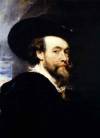 Antwerp was home to Peter Paul Rubens, Belgium's most influential artist in early 17th century. Museums and churches around the city display some of his most famous paintings such as ‘The Descent from the Cross' (1612). One of Antwerp's most prized possessions is the artist's home, which also served as a studio where Rubens taught and worked.
Antwerp was home to Peter Paul Rubens, Belgium's most influential artist in early 17th century. Museums and churches around the city display some of his most famous paintings such as ‘The Descent from the Cross' (1612). One of Antwerp's most prized possessions is the artist's home, which also served as a studio where Rubens taught and worked.
Antwerp Zoo
 The Antwerp Zoo is located in the middle of the city center next to Antwerp Central Station. It is one of the oldest zoological gardens in the world and has over 5000 animals on display. It is also a wonderful place to stroll around on a sunny afternoon or to relax after a visit to the main shopping street Meir.
The Antwerp Zoo is located in the middle of the city center next to Antwerp Central Station. It is one of the oldest zoological gardens in the world and has over 5000 animals on display. It is also a wonderful place to stroll around on a sunny afternoon or to relax after a visit to the main shopping street Meir.
More information
You can find more information about visiting Antwerp at:
Other major cities and locations
You can easily travel from Antwerp to one of these cities using local trains (most of them are about one hour apart).
Brussels
 Brussels is the bilingual capital of Belgium: both French (Bruxelles) and Dutch (Brussel) are the official languages of the city. Street names and traffic sings are always in these two languages. Furthermore, it is a cosmopolitan city where many different cultures live together and where different languages can be heard on each street. This liveliness and international flair is, of course, intimately related to its role as a crossroads for all of Europe.
Brussels is the bilingual capital of Belgium: both French (Bruxelles) and Dutch (Brussel) are the official languages of the city. Street names and traffic sings are always in these two languages. Furthermore, it is a cosmopolitan city where many different cultures live together and where different languages can be heard on each street. This liveliness and international flair is, of course, intimately related to its role as a crossroads for all of Europe.
The same variety and contrast can also be found in the different architectural styles that can be found in Brussels. Gothic cathedrals and churches are next to - and sometimes in stark contrast with - gracious classical facades like the buildings around the Royal Square or beautiful Art Nouveau and Art Deco houses. Brussels is the city par excellence in which this very special eclectic style had been given the free rein.  The best examples are scattered all over the city. In the quartier Louise, you will discover the houses of architects Paul Hankar and Victor Horta. The area around the Etangs d'Ixelles (Ixelles Ponds) reflects the personalities of E. Blérot and L. Delune. On the way you will discover the charming Hotel Solvay (Unesco World Heritage List, 2000), built by Victor Horta for the famous industrialist. Brussels also houses the Hotel Tassel, the Hôtel Van Eetvelde, the house of painter Saint-Cyr and the Maison Cauchie, one of the most beautiful examples of Art Nouveau.
The best examples are scattered all over the city. In the quartier Louise, you will discover the houses of architects Paul Hankar and Victor Horta. The area around the Etangs d'Ixelles (Ixelles Ponds) reflects the personalities of E. Blérot and L. Delune. On the way you will discover the charming Hotel Solvay (Unesco World Heritage List, 2000), built by Victor Horta for the famous industrialist. Brussels also houses the Hotel Tassel, the Hôtel Van Eetvelde, the house of painter Saint-Cyr and the Maison Cauchie, one of the most beautiful examples of Art Nouveau.
The heart of Brussels and the place to start getting to know the city is however the Grand Place. This historic market square with its splendid guild houses and the impressive Gothic beauty of the Town Hall, is widely considered to be one of the most beautiful town squares in Europe.
Bruges
Bruges is called : 'the Venice of the North'. This splendid medieval city is one of Belgium's crown jewels. In no other European city the feel and the look of medieval times are so present as here in this city close to the North Sea.
The attractions of this magical place include a wide range of museums, churches, historical buildings and canals and streets that can be explored by boat, foot or horse.
You can find more information about visiting Bruges at http://www.visit-bruges.com/ and http://www.trabel.com/brugge.htm
Charleroi
 Charleroi is the economic and cultural centre of more than half a million inhabitants. It is favourably located 50 kilometres (30 miles) south of Brussels, and is a good gateway for a visit to the Belgian Ardennes. The belfrey of Charleroi, which is listed on the UNESCO World Heritage List, is worthwhile to visit. There is also the Maison which was built by the Art Nouveau architect Alfred Frère in 1899.
Charleroi is the economic and cultural centre of more than half a million inhabitants. It is favourably located 50 kilometres (30 miles) south of Brussels, and is a good gateway for a visit to the Belgian Ardennes. The belfrey of Charleroi, which is listed on the UNESCO World Heritage List, is worthwhile to visit. There is also the Maison which was built by the Art Nouveau architect Alfred Frère in 1899.
Detailed information can be found at the Visit Charleroi website.
Ghent
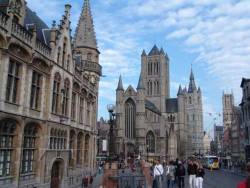 Ghent is one of the most beautiful historic cities in Europe which combines a mixture of past and present. The historic heart of Ghent offers a lot of places of interest. From St Michael's bridge there is a wonderful view on the skyline of Ghent with the three impressive towers of St Nicholas' Church, the Belfry with its bell tower and St Bavo's cathedral with the world famous painting “The Adoration of the Mystic Lamb” by Jan van Eyck. Much of the medieval city of Ghent has been preserved throughout the city. The old port with its guild halls on the Graslei and Korenlei is just one example of the beautiful views this city has to offer you.
Ghent is one of the most beautiful historic cities in Europe which combines a mixture of past and present. The historic heart of Ghent offers a lot of places of interest. From St Michael's bridge there is a wonderful view on the skyline of Ghent with the three impressive towers of St Nicholas' Church, the Belfry with its bell tower and St Bavo's cathedral with the world famous painting “The Adoration of the Mystic Lamb” by Jan van Eyck. Much of the medieval city of Ghent has been preserved throughout the city. The old port with its guild halls on the Graslei and Korenlei is just one example of the beautiful views this city has to offer you.
The Castle of the Counts was once the medieval fortress of the Count of Flanders. Today it's one of Ghent's main tourist attractions. The city also has several museums, abbeys, beguinages, dozens of churches and historical buildings.
http://www.gent.be/gent/english/index.htm and http://www.trabel.com/gent.htm
Liège
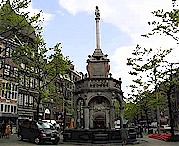 Liège, daughter of the Meuse river. Liège is called 'La cité ardente' (the fiery city). A city at the crossroads of Northern and Southern European culture. Although the place was already inhabited in the Paleolithic era, the development of the city dates back to the murder of bishop Saint Lambert in 705 AD. Formerly a world-leading coal and steel industrial center, Liège is nowadays a rapidly changing city where old meets new.
Liège, daughter of the Meuse river. Liège is called 'La cité ardente' (the fiery city). A city at the crossroads of Northern and Southern European culture. Although the place was already inhabited in the Paleolithic era, the development of the city dates back to the murder of bishop Saint Lambert in 705 AD. Formerly a world-leading coal and steel industrial center, Liège is nowadays a rapidly changing city where old meets new.
Take a walk through the old city center and discover the typical traffic-free alleys and shopping streets where terraces abound. Visit the central St. Lambert square where a new modern Liège is growing. Check the 'Perron' (photo), symbol of the city's freedoms. Take a walk alongside the banks of the majestically flowing Meuse river and see Liège from a distance.
Liège has a number of very interesting museums with collections that rank among the most interesting in Belgium. Liège is also the city of Georges Simenon (1903 - 1989), the creator of police detective Maigret.
Further details on trabel.com
Coastal region
 When the summer heat turns oppressive in Brussels, do as the Belgians do: head for the coast of Flanders and take a dip in the North Sea.
When the summer heat turns oppressive in Brussels, do as the Belgians do: head for the coast of Flanders and take a dip in the North Sea.
The Flanders coast is situated only 120 kilometers to the west of Brussels. You can easily get there from Brussels by train or by car. Interestingly, it is about the shallowest part of the North Sea as at 10 km from the coast, it is barely 10 m deep. The natural dunes have in many places been flattened and replaced by a sea wall which was transformed into a long and wide promenade making a stroll by the sea a real pleasure.
The most popular tourist destinations along the coast line are the following:
Blankenberge with a classic pier (built in 1933) and a Sea Life Center where visitors can view more than 70 types of fish from an underwater tunnel. De Panne, where there are still some of the original dunes left thus claiming a third of the dunes on the Flanders Coast. Oostende which is a thousand-year-old city with marinas, an old fishing port, a casino, a lively downtown, and high-speed ferry connections to England.
You can find more information about the coast at: http://www.dekust.org/EN/visitor/
Flanders Fields
From 1914 to 1918 the 'Westhoek', i.e. the area of Nieuwpoort, Diksmuide, Ieper (Ypres), Poperinge, was the scene of the Great War. Hundreds of thousands of soldiers of more than 20 nationalities fell in this conflict. After the often pointless battles and vast destruction, the Westhoek rose from its ashes. Today the Westhoek wants to spread a message of peace all over the world, with the In Flanders Fields Museum in Ypres, the IJzertoren in Diksmuide, the numerous military cemeteries, the war memorials and sites.
